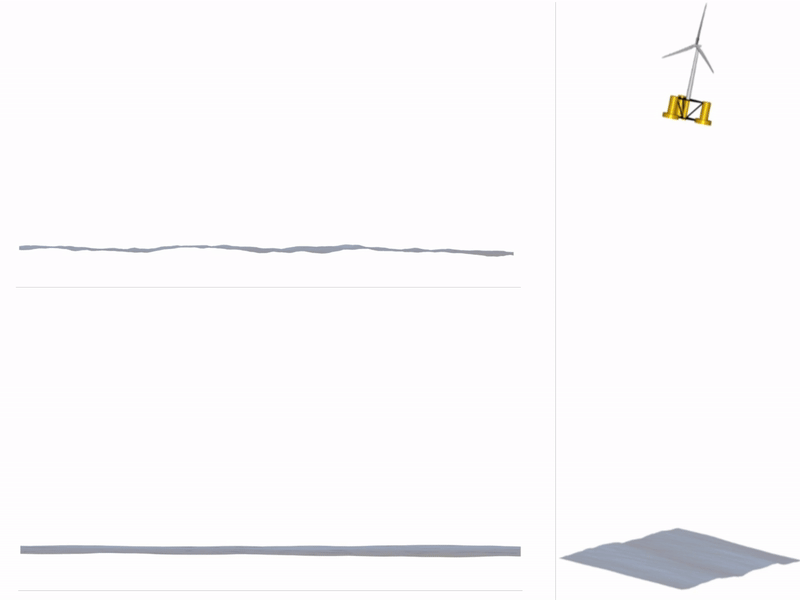Forum
High Solidity VAWT and LLFVW parameters
Quote from Pedro Goncalves on 8. February 2024, 16:44Hello,
I am currently doing a project on the aerodynamic characteristics and general behaviour of a VAWT but I have been having some doubts on the application of some models and some choices of parameters.
- I have come across information suggesting the limitations of DMS when applied to high solidity turbines, which is the case for my design (5 helicoid blades closely spaced). Could you provide any insights into whether DMS results can be considered reliable for such a high solidity design?
- For the LLFVW model, I have been unable to find clear guidelines on how to make the selection for the vortex parameters when experimental data is not available for comparison and tuning. How would you recommend determining the appropriate values for the vortex parameters when conducting LLFVW?
- When applying different Dynamic Stall models, significant variations can be found in the results depending on which model is being used, with some models increasing power output while others decreasing when compared with the standard LLFVW with no DS models added. Similar to the previous problem, could you offer insights into selecting the most appropriate model when no experimental data is available?
Thanks,
Pedro Gonçalves
Hello,
I am currently doing a project on the aerodynamic characteristics and general behaviour of a VAWT but I have been having some doubts on the application of some models and some choices of parameters.
- I have come across information suggesting the limitations of DMS when applied to high solidity turbines, which is the case for my design (5 helicoid blades closely spaced). Could you provide any insights into whether DMS results can be considered reliable for such a high solidity design?
- For the LLFVW model, I have been unable to find clear guidelines on how to make the selection for the vortex parameters when experimental data is not available for comparison and tuning. How would you recommend determining the appropriate values for the vortex parameters when conducting LLFVW?
- When applying different Dynamic Stall models, significant variations can be found in the results depending on which model is being used, with some models increasing power output while others decreasing when compared with the standard LLFVW with no DS models added. Similar to the previous problem, could you offer insights into selecting the most appropriate model when no experimental data is available?
Thanks,
Pedro Gonçalves
Quote from David on 8. February 2024, 18:39Hello Pedro,
as you already mention, the DMS only works realiable for very low solidity rotor, such as the one seen below. For a rotor with 5 blades I would strongly advise against using the DMS.
Regarding the LLFVW: The standard parameter are a good starting point and work for almost all cases. If you are simulating with 5-blades there will be comparably more vortex elements generated per timestep, as compared to a 3-balded rotor, which increases the compuational effort.
Furthermore, I would suggest to start the simulation with a “wake relaxation” parameter of around 0.7-0.8, to get rid of the starting vortex. To get the cp-value you then need to simulate sufficiently long enough so that the wake is fully developed and the rotor has reached a steady operational stage.
For a dynamic stall model in the context of Vertical Axis Wind Turbines (VAWTs), I suggest using the Gormont-Berg model. This model is more adept at handling the significant angle of attack fluctuations typically encountered in VAWTs, as compared to other dynamic stall models that are available in QBlade.
BR,
David
Hello Pedro,
as you already mention, the DMS only works realiable for very low solidity rotor, such as the one seen below. For a rotor with 5 blades I would strongly advise against using the DMS.

Regarding the LLFVW: The standard parameter are a good starting point and work for almost all cases. If you are simulating with 5-blades there will be comparably more vortex elements generated per timestep, as compared to a 3-balded rotor, which increases the compuational effort.
Furthermore, I would suggest to start the simulation with a “wake relaxation” parameter of around 0.7-0.8, to get rid of the starting vortex. To get the cp-value you then need to simulate sufficiently long enough so that the wake is fully developed and the rotor has reached a steady operational stage.
For a dynamic stall model in the context of Vertical Axis Wind Turbines (VAWTs), I suggest using the Gormont-Berg model. This model is more adept at handling the significant angle of attack fluctuations typically encountered in VAWTs, as compared to other dynamic stall models that are available in QBlade.
BR,
David
Quote from Pedro Goncalves on 15. February 2024, 09:53Thank you, greatly appreciated.
Pedro Gonçalves
Thank you, greatly appreciated.
Pedro Gonçalves


